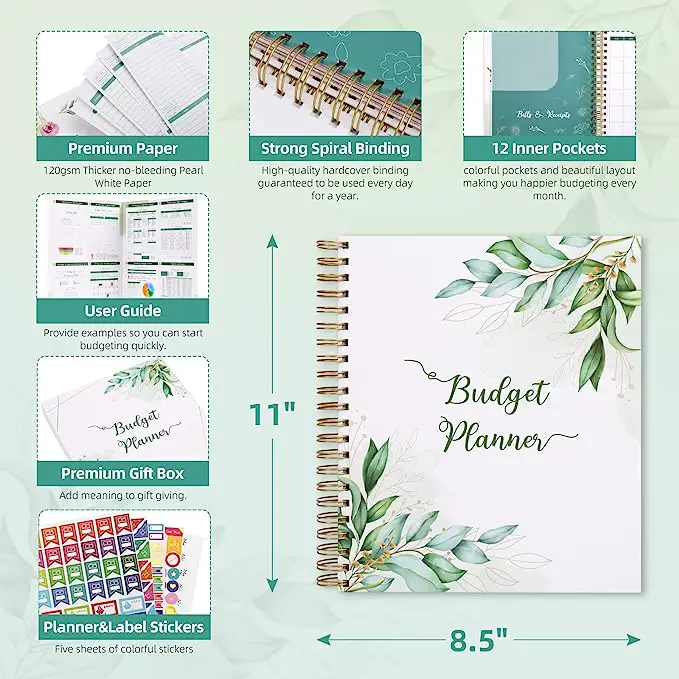Let us address some bills that must be accounted for in a family budget. The first essential category is the cost of shelter, whether a personal home or rent. That cost needs to be included in the family budget. After this cost, the other bills should be things that keep the home running, such as utilities, food, or even groceries, which are still essential in a family budget. Lastly, health expenses and childcare are other categories that should be included.
When creating a household budget, finding essential bill categories that must be included to cover your basic living expenses is crucial.
Check out the following tool on Amazon for budgeting tips and tricks:

While specific bills may vary depending on individual circumstances, here are some common essential bill categories to consider:
- Housing: This includes your mortgage or rent payments, property taxes, homeowners or renters’ insurance, and any maintenance or repair costs associated with your home. Housing expenses typically make up a significant portion of a household budget. If you own a home, you must account for mortgage or loan payments, property taxes, and homeowners insurance. If you rent, include monthly rent payments and renter’s insurance.
- Utilities: Include expenses such as electricity, gas, water, and sewer bills. Consider other utility expenses like internet, cable TV, and phone services. Utilities include essential services like electricity, gas, water, and sewer.
- Transportation: This category encompasses vehicle-related expenses, including car loan or lease payments, fuel costs, auto insurance, maintenance and repairs, parking fees, and public transportation fares. Be sure to account for all transportation-related expenses based on your needs and mode of transport.
- Food: Account for groceries, dining out, and any food delivery or meal subscription services. Be sure to include essential household supplies as well. When determining this category, consider your household’s eating habits, dietary needs, and whether you prefer to cook at home or eat out.
- Health Care: This includes health insurance premiums, prescription medications, doctor visits, dental care, vision care, and any other medical expenses or health-related insurance premiums. Health care expenses encompass health insurance premiums, prescription medications, co-pays for doctor visits or specialist appointments, dental care, vision care, and any other costs you anticipate.
- Debt Payments: If you have outstanding debts, distribute funds for minimum payments on credit cards, student loans, personal loans, or any other debts you may have. It’s vital to address debt obligations as part of your budgeting process.
- Insurance: Consider other insurance policies you or your family hold, such as life insurance, disability insurance, or long-term care insurance, and include their premiums in your budget. Apart from homeowners or renters insurance and auto insurance, consider other insurance policies you hold, such as life insurance, disability insurance, or long-term care insurance. Include their premiums in your budget.
- Personal Care: Allocate funds for toiletries, haircuts, salon services, and other expenses. Personal care expenses cover self-care items, such as toiletries, haircuts, salon services, skincare products, and personal care needs.
- Childcare and Education: If you have children, include expenses related to childcare, daycare, or after-school programs. Also, consider costs associated with their education, such as school fees, tuition, and supplies if you have children, and budget for childcare expenses, including daycare or after-school programs.
- Clothing: Account for expenses related to clothing and footwear for yourself and your family members. This can include everyday wear, work attire, and seasonal items. Allocate funds for clothing and footwear expenses for yourself and your family members. Consider daily wear and any specific clothing needs for work or special occasions.
- Taxes: Set aside funds for income taxes, property taxes, or any other tax obligations you may have. Account for income taxes and property taxes in your budget. If you are self-employed or have other tax obligations, include estimated tax payments.
- Saving and Investing: It is crucial to distribute a part of your budget towards savings and investments to build an emergency fund, save for future goals, and contribute to retirement accounts. Building financial stability requires allocating a portion of your budget towards savings and investments. Prioritize saving for an emergency fund and contribute to retirement accounts, such as a 401(k) or individual retirement account (IRA).
- Miscellaneous: Create a category for miscellaneous expenses that may arise, such as home or car maintenance emergencies, household repairs, or unexpected medical costs. Create a category for miscellaneous expenses that don’t fit into other predefined categories. This can include unexpected home or car repairs, medical emergencies, or additional unanticipated costs.
Remember, the breakdown of bill categories may vary depending on your circumstances and financial priorities. Reviewing your spending patterns and financial obligations to ensure you include all necessary expenses in your household budget is essential. Remember that personal circumstances may vary, and it’s important to customize your budget to reflect your needs and financial goals. Regularly review and adjust your budget to align with your priorities and financial situation.

Determining the appropriate allocation for each bill category in your budget requires careful consideration of your circumstances and financial goals. Here are some steps to help you choose the funding for each type:
- Assess Your Income: Start by evaluating your total monthly income. Calculate the amount you earn from all sources, including salaries, wages, investments, and any other regular sources of revenue.
- Track Your Expenses: Track your expenses for a few months to clearly understand where your money is being spent. Categorize your expenses into different categories (e.g., housing, transportation, food) to identify patterns and see how much you spend in each area.
- Prioritize Essential Expenses: Identify the essential bill categories discussed earlier (housing, utilities, transportation, etc.). Your budget should prioritize these categories, as they cover your basic needs and obligations.
- Determine Fixed vs. Variable Expenses: Differentiate between fixed expenses (those that remain relatively stable each month, such as rent or mortgage payments) and variable expenses (those that fluctuate, such as groceries or utility bills). Fixed fees are easier to plan for, while variable costs may require some estimation based on past spending patterns.
- Consider Percentage Guidelines: Some financial experts recommend using percentage guidelines as a starting point for budgeting. For example, allocating around 30% of your income to housing, 10-15% to transportation, 10-15% to food, 5-10% to debt payments, etc. These are general guidelines, and you can adjust them based on your specific circumstances and priorities.
- Evaluate Your Financial Goals: Consider your short-term and long-term financial goals. These may include saving for emergencies, paying off debt, saving for education or retirement, or other specific objectives. Allocate funds towards these goals as a separate category in your budget.
- Adjustments and Flexibility: As you allocate funds to each category, evaluate whether the amounts allotted align with your priorities and financial capacity. Be prepared to make adjustments and find a balance that works for you. Flexibility is essential, as your circumstances or goals may change over time.
- Regularly Review and Revise: It’s crucial to review your budget regularly, ideally every month, to ensure it remains realistic and practical. Monitor your actual spending against your budgeted amounts and make adjustments as needed. This practice lets you stay on track and make necessary changes to achieve your financial goals.
Remember, budgeting is a personal process, and there is no one-size-fits-all approach. It requires ongoing evaluation, discipline, and adjustments to suit your circumstances. Be realistic and considerate of your financial situation, and balance meeting your essential needs and saving for your and your family’s financial future.


